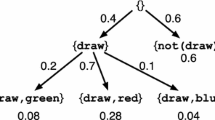Abstract
The aim of these notes is to give a compact but complete presentation of the basic ideas behind logic programming. The emphasis throughout is on logical principles and on the main ideas of the most useful algorithms. These are concretely realized, although not always in the purest form, in various versions of PROLOG. We shall not be much concerned with how PROLOG is actually implemented, however, since the details vary considerably from system to system and tend to obscure the relatively simple conceptual framework which lies beneath the surface.
Access this chapter
Tax calculation will be finalised at checkout
Purchases are for personal use only
Preview
Unable to display preview. Download preview PDF.
Similar content being viewed by others
References
Boyer, R.S. and Moore, J S. The sharing of structure in theorem proving programs. Machine Intelligence 7, Edinburgh University Press, 1972, 101–116.
Clark, K.L Negation as failure. In Logic and Databases, edited by Gallaire and Minker, Plenum Press, 1978, 293–322.
Clark, K.L. Predicate logic as a computational formalism. Ph.D. Thesis, Imperial College, London, 1979.
Colmerauer, A., et al. Un systeme de communication homme-machine en francais. Groupe d’Intelligence Artificielle, U.E.R. de Luminy, Universite d’Aix-Marseille, Luminy, 1972.
Green, C.C. Application of theorem proving to problem solving. Proceedings of First IntemationalJointConference on Artificial Intelligence, Washington D.C., 1969, 219–239.
Hill, R. LUSH resolution and its completeness. DCL Memo 78, University of Edinburgh Department of Artificial Intelligence, August 1974.
Huet, G. Resolution d’equations dans les langages d’ordre 1, 2,..., ω. These d’Etat, Universite Paris VII (1976).
Kowalski, R.A. Predicate logic as programming language. Proceedings of IFIP Congress 1974, North Holland, 1974, 569–574.
Knuth, D. E. The Art of Computer Programming, Volume 1, Addison-Wesley 1969, 258–268.
Martelli, A. and Montanari, U. Unification in linear time and space. Technical Report B76–16, University of Pisa, Italy, 1976.
Paterson, M. S., and Wegman, M. N. Linear unification. Journal of Computer and Systems Sciences 16, 1978, 158–167.
Robinson, J. A. A machine-oriented logic based on the resolution principle. Journal of the Association for Comptuting Machinery 12, 1965, 23–41.
Robinson, J. A. Automatic deduction with hyper-resolution. International Journal of Computer Mathematics 1, 1965, 227–234.
Tarjan, R. E. Efficiency of a good but not linear set union algorithm. Journal of the Association for Computing Machinery 22, 1975, 215–225.
van Emden, M.H., and Kowalski, R.A. The semantics of predicate logic as a programming language. J.ournal of the Association for Computing Machinery 23, 1976, 733 – 742.
Vitter, J. S., and Simmons, R. A. New classes for parallel complexity: a study of unification and other complete problems for P. I.E.E.E.Transactions on Computers, Vol C-35, May 1986, 403–417.
Lloyd, J. W. Foundations of logic programming. Springer-Verlag, 1984.
Author information
Authors and Affiliations
Editor information
Editors and Affiliations
Rights and permissions
Copyright information
© 1987 Springer-Verlag Berlin Heidelberg
About this paper
Cite this paper
Robinson, J.A. (1987). Notes on Logic Programming. In: Broy, M. (eds) Logic of Programming and Calculi of Discrete Design. NATO ASI Series, vol 36. Springer, Berlin, Heidelberg. https://doi.org/10.1007/978-3-642-87374-4_6
Download citation
DOI: https://doi.org/10.1007/978-3-642-87374-4_6
Publisher Name: Springer, Berlin, Heidelberg
Print ISBN: 978-3-642-87376-8
Online ISBN: 978-3-642-87374-4
eBook Packages: Springer Book Archive




